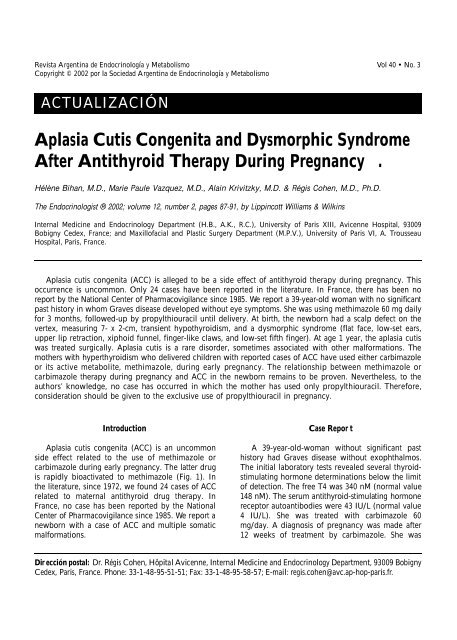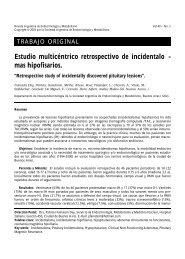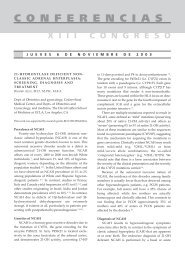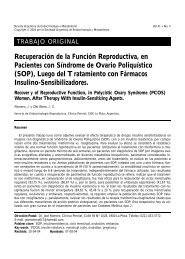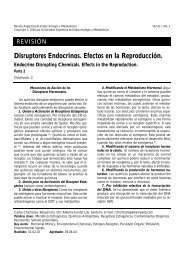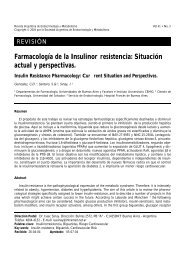Aplasia Cutis Congenita and Dysmorphic Syndrome After ...
Aplasia Cutis Congenita and Dysmorphic Syndrome After ...
Aplasia Cutis Congenita and Dysmorphic Syndrome After ...
Create successful ePaper yourself
Turn your PDF publications into a flip-book with our unique Google optimized e-Paper software.
198 ANTITHYROID THERAPY AND APLASIA CUTIS CONGENITA RAEM • 2003Vol 40 • No. 3Figure 3. The dysmorphic syndrome, including flat face, low-setears, <strong>and</strong> upper lip retraction, in the daughter of a patient tre a t e dwith carbimazole.chrom o s o m a la b n o rmalities <strong>and</strong> also various somaticmalformation syndromes 2 . Frieden 3 developed aclassification for the disease. Observed malform a t i o n sinclude hypertelorism, microphthalmia, micro c e p h a l y ,ear malformations, polydactyly, genital hypoplasia,renal abnormalities, <strong>and</strong> mental deficiency. Thec h romosomal abnormalities, which are identifiedon occasion, include a 4p deletion (Wolf-Hischhornsyndrome), tetrasomy 12, or trisomy 13. In somewell-identified syndromes, the mode of transmissionhas been established to be autosomal dominant( e c t o d e rmal dysplasia, scalp-ear-nipple [SEN]s y ndrome, Adams-Oliver syndrome), or autosomalrecessive (Johanson-Blizzard syndrome), or X-linked.Others have proposed causes for ACC, includingepidermolysis bullosa, placental abnormalities ( l a c kof resorption, tears, or abnormal amniotic b<strong>and</strong>sduring delivery), viral infections (herpes simplex,varicella), toxins (heroin, cocaine), <strong>and</strong>, occasionally,intrauterine exposure to methimazole, prostagl<strong>and</strong>inE 1 analogs, valproic acid, <strong>and</strong> misoprostol.Importantly, in the literature, 24 cases of ACChave been described subsequent to exposure tomethimazole or carbimazole during pre g n a n c y(Table 1). In most cases, these drugs have beenadministered during the first 2 months of pregnancy<strong>and</strong> then often replaced by propylthiouracil untildelivery. The newborns had one or more areas ofACC, occasionally associated with the absence ofunderlying bone (two infants) 4,5 . Sometimes, theskin defects had closed spontaneously within a fewmonths. Indeed, some believe that cases of ACCmay be missed because the healing has occurredduring intrauterine life. Four newborns (two sets oftwins) had malformations, mostly related to umbilicalimmaturity, such as patent urachus. Choanal atresia,esophageal atresia, or tracheoesophageal fistulaeare also described 6,7 .The precise cause of ACC is unknown 8,9 . Thereis no apparent link to maternal age (the motherswere between ages 20 <strong>and</strong> 40 years) <strong>and</strong> no relationto dose (ranging from 5-60 mg/day; 15 mg/day inmost cases). The reported associated malformations(five cases) have suggested that there might be agenetic predisposition to ACC, which is revealed bymethimazole. Other malformations have beendescribed after treatment with methimazole duringpregnancy. These include choanal atresia, intestinalanomalies (imperforate anus, esophageal atresia),cardiovascular defects, <strong>and</strong> facial anomalies 10,12 .Johnsson et al. 13 reported a severe case associatingmany of these later malformations. Thyroid statusmay play a role. It is known that the frequency ofmalformations is greater for infants born to motherswith hyperthyroidism (3%–6% vs. 0.2% for theinfants born to mothers with euthyroidism) 9 , 1 4 . Thesem a l f o rmations include omphalocele, imperforate anus,anencephaly, malformation of the earlobe, harelip,<strong>and</strong> polydactyly; the same as those reported aftertreatment by methimazole. In our case, the motherhad hyperthyroidism during the embryogenesis.Some studies investigated the specific re l a t i o n s h i pbetween ACC <strong>and</strong> methimazole therapy. At the
HÉLÈNE BIHAN, M.D. Y COL.199University Hospital of Amsterdam, during a periodof 27 years, 48,057 mothers gave birth to 49,091newborns. Twenty-five children had ACC (0.05%),which was confined to the scalp in 0.03% (13infants). None of the mothers had used antithyroiddrugs during pregnancy 1 . Momotani et al. 1 4 e v a l u a t e d243 infants whose mothers had been treated withmethimazole during pregnancy. Two had malformations(omphalocele, abnormalities of the earlobe),but none had scalp defects. These malformationsare reported in 1.7% of infants whose mothersreceived methimazole <strong>and</strong> had hyperthyroidism <strong>and</strong>in no infants whose mothers were t reated bym e t h imazole but were euthyroid. One study re p o r t e dthe three-fold increase in the frequency of thisanomaly in certain regions of Spain where there wasillegal use of methimazole as a fattening agent inanimal feed 1 5 .The latest study from Wing et al. 16 concludedthat propylthiouracil <strong>and</strong> methimazole are equallysafe. The incidence of major anomalies in infantsexposed to these drugs is not different from that ofthe general population. The incidence was 3% (3 of99) in infants of propylthiouracil-treated mothers.The mothers of these infants had hyperthyroidismduring the period of embryogenesis. These infantshad pulmonic stenosis, ventricular septal defect, <strong>and</strong>patent ductus arteriosus. In infants of methimazoletreated mothers, the incidence of anomalies was 2.7%(1 of 36 infants had a congenital inguinal hernia; hismother had euthyroidism). No case of ACC was found.No scalp defects have been observed in infantsTable 1Review of the Twenty Five Cases of ACC in Relation With Antithyroid Described in LiteratureNumber of patient, author, date, reference Treatment dose per day Comments1-2 - Milham et al., 1972 (15) Carbimazole 1 twin3 2nd with a patent urachus4-5 - Mujtaba et al., 1975 (7) Methimazole (15 to 5 mg) 1st infant, imperforate anus minimalhypospadiaL-thyroxin (120 to 60 µg)2nd newborn no malformationMethimazole (5 mg)6-9 - Milham, 1981 (6) ? Patent urachus10-14 - Bachrach et al., 1984 (20) ? Oral report15 - Farine et al., 1988 (21) Methimazole Elevation of alpha-feto-protein atthe beginning of pregnancy16 - Kalb et al., 1986 (4) Methimazole (10 mg; 50 mg subsequently) 1st term absence of underlying bone17 - Van Dijke et al., 1987 (1) Methimazole (20 mg) 3 areas of ACCL-thyroxin (50 µg)1st spontaneous healing18 - Dutertre et al., 1991 (5) Methimazole (15 mg the 1st. irregular Absence of underlying boneduring the 2nd trimester)19 - M<strong>and</strong>el et al., 1994 (11) Methimazole (30 mg 3 months, then One area of ACC subtotal60 mg, then 90 mg) thyroidectomyL-thyroxin (200 µg)20 - Vogt et al., 1995 (8) Methimazole (20 mg) Numerous areas of aplasia cutisTransient hypothyroidism21 - Clementi et al., 1999 (10) Methimazole Numerous areas of ACC choanalatresia, atresia of the stomach,dysmorphic face, mental retardation22 - Diez-Delgado Rubio et al., 1999 (18) Methimazole (5 mg the 1st <strong>and</strong> 2nd trimester) ACC only23 Methimazole 10 mg 6 weeks ACC only24 - Martinez Frias et al., 1992 (19) Carbimazole Citation in the text25 - Bihan et al., 2002 (current case) Carbimazole (60 mg) for 3 months flat face, low-set ears, upper lipretraction, xyphoid funnel, finger-likeclaws, <strong>and</strong> low-set 5th finger
200 ANTITHYROID THERAPY AND APLASIA CUTIS CONGENITA RAEM • 2003Vol 40 • No. 3whose mothers had been treated only withp ropylthiouracil, even though this drug isadministered more frequently than methimazole. Isthis disparity caused by diff e rences in theirmetabolism <strong>and</strong>/or passage across the placenta?Methimazole, which exhibits negligible pro t e i nbinding, is lipid-soluble. It crosses the placentarapidly by a simple diffusion process. Appro x i m a t e l y0.9% of the cumulative dose administered to themother during her pregnancy can be found in thefetal serum. In contrast, propylthiouracil is bound toprotein (60%-70%) <strong>and</strong> is less lipid-soluble. Itsmetabolism is rapid. The drug is quickly excreted asglucuronic acid conjugates. Thus, the placentaltransfer of propylthiouracil may be limited. Morerecently, a study was performed on the isolated,perfused, term-human placenta. In this study, thetransfer of low <strong>and</strong> high doses of propylthiouracil<strong>and</strong> methimazole from the maternal to the fetalc i rculation was investigated, with or without theaddition of bovine albumin. No diff e rence was foundbetween the transfer of the drugs, the elimination rateconstants, or the clearances 1 7 .In this respect, as far as the fetal hypothyroidisminducingpotential is concerned, there is apparentlyno diff e rence between propylthiouracil <strong>and</strong>m e t h imazole 14 . The apparent relationship betweenACC <strong>and</strong> methimazole is not certain. Because of therarity of ACC, a prospective clinical study will bed i fficult to perform. It is also uncertain whethermethimazole is harmful only if administered during thefirst trimester. Nevertheless, among cases associatedwith the maternal administration of antithyroiddrugs during early pregnancy, the relationship tomethimazole (or carbimazole) is striking. Accordingly,we recommend the avoidance of these two drugsduring pregnancy. In all women of child-bearingage with hyperthyroidism, a pregnancy test shouldbe performed before therapy. If the test result isnegative, contraception should be initiated.F u r t h e rm o re, because propylthiouracil ingestionduring early pregnancy has, to our knowledge, neverbeen associated with ACC, we recommend theexclusive use of this antithyroid drug for the womanwith hyperthyroidism who is already pregnant.AcknowledgmentsThe authors thank Dr. Kenneth Becker(Washington University, USA) for his critical help inthe preparation of this manuscript.References1. Van Dijke, C.P.; Heydendael, R.J.; De Kleine, M.J.Methimazole, carbimazole <strong>and</strong> congenital skindefects. Ann Intern Med 1987; 106:60-1.2. Evers, M.E.J.W.; Steijlen, P.M.; Hamel, B.C.J.<strong>Aplasia</strong> cutis congenita <strong>and</strong> associated disorders:an update. Clin Genet 1995; 47: 295-301.3. Frieden, I.J. <strong>Aplasia</strong> cutis congenita: a clinicalreview <strong>and</strong> proposal for classification. J Am AcadDermatol 1986; 14: 646-60.4. Kalb, R.E.; Grossman, M.E. The association ofaplasia cutis congenita with therapy of maternalthyroid disease. Pediatr Dermat 1986; 3:327-30.5. Dutertre, J.P.; Jonville, A.P.; Moraine, C. et al.<strong>Aplasia</strong> cutis après exposition in utero aucarbimazole. J Gynecol Obstet Biol Reprod(Paris) 1991; 20: 575-6.6. Milham, S. Scalp defects in infants of motherstreated for hyperthyroidism with methimazole orcarbimazole during pregnancy. Teratology 1985;32:321.7. Mujtaba, Q.; Bur row, G.N. Treatment of hyperthyroidismin pregnancy by propylthiouracil <strong>and</strong>methimazole. Obstet Gynecol 1975; 46: 282-6.8. Vogt, T.; Stolz, W.; L<strong>and</strong>thaler, M. <strong>Aplasia</strong> cutiscongenita after exposure to methimazole: a causalrelationship? Br J Dermatol 1995; 133: 994-6.9. M<strong>and</strong>el, S.J.; Cooper, D.S. The use of antithyroiddrugs in pregnancy <strong>and</strong> lactation. J ClinEndocrinol Metab 2001; 86: 2354-9.10. Clementi, M.; Di Gianantonio, E. Methimazoleembryopathy: delineation of the phenotype. AmJ Med Genet 1999; 83: 43-6.11. M<strong>and</strong>el, S.J.; Brent, G.A.Z.; Larsen, P.R. Reviewof antithyroid drug use during pregnancy <strong>and</strong>report of a case of aplasia cutis. Thyroid 1994; 4:129-33.
HÉLÈNE BIHAN, M.D. Y COL.20112. Dumont, M. A propos de l’aplasie cutanée chezle nouveauné et le rôle du carbimazole. J GynecolObstet Biol Reprod (Paris) 1991; 20: 865-6.13. Johnsson, E.; Larsson, G.; Ljunggren, M. Severemalformation in infant born to hyperthyroidwoman on methimazole. Lancet 1997; 350: 1520.14. Momotani, N.; Ito, K.; Hamada, N. et al. Maternalhyperthyroidism <strong>and</strong> congenital malformation inthe offspring. Clin Endocrinol (Oxf) 1984; 20:695-700.15. M a rtinez-Frias, M.L.; Cereijo, A.; Rodriguez-Pinilla, E. et al. Methimazole in animal feed <strong>and</strong>congenital aplasia cutis. Lancet 1992; 339: 742–3.16. Wing, D.A.; Millar, L.K.; Koonings, P.P. et al. Acomparison of propylthiouracil versus methimazolein the treatment of hyperthyroidism in pre g n a n c y .Am J Obstet Gynecol 1994; 170: 90-5.1 7 . M o rt i m e r , R.H.; Cannell, G.R.; Addison, R.S.et al. Methimazole <strong>and</strong> propylthiouracil equallyc ross the perfused human term placentallobule. J Clin Endocrinol Metab 1997; 82: 3099-102.18. Diez-Delgado Rubio, J.; Belmonte Martin, M.J.;Calvo Bonachera, M.D. et al. <strong>Aplasia</strong> cutis as ateratogenic effect of methimazole. Ann EspPediatr 1999; 51: 290-2.19. Milham, S.; Elledge, W . Maternal methimazole<strong>and</strong> congenital defects in children. Teratology1972; 5: 125.20 . Bachrach, L.K.; Burr o w, G.N. <strong>Aplasia</strong> cutisc o ngenita <strong>and</strong> methimazole. Can Med Assoc J1984 130: 1264.21. Farine, D.; Maidman, J.; Rubin, S. et al. Elevatedalpha-fetoprotein in pregnancy complicated byaplasia cutis after exposure to methimazole.Obstet Gynecol 1988; 71: 996–7.CONSULTORIOS SE ALQUILAN POR HORA3 consultorios a estrenar con excelente ubicación en Capital Federal (Viamonte yPueyrredón). Amplios (aprox. de 4 x 3 mts.), muy iluminados, con buena ventilación, a i reacondicionado y amoblamiento nuevo. Cuenta con teléfono, fax, PC e impre s o r a.El precio del alquiler, sumamente accesible, incluye Secretaría (para recepción de turnosy pacientes), Servicios y Expensas.Consulte nuestros descuentos y aranceles especiales al 4-964-2191.


